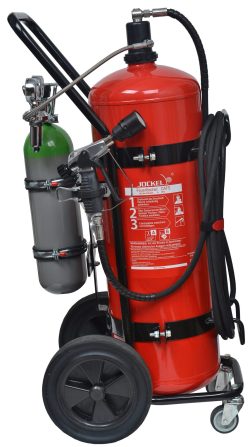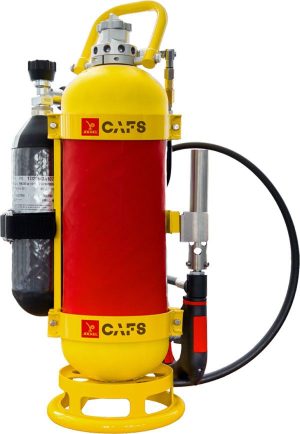

CAFS fire extinguishers are primarily professional devices suitable for trained users. They are used by fire brigades and plant fire brigades and are used in companies that are subject to particular fire hazards, such as in the chemical, petrochemical, off shore areas, recycling industries or in the metalworking industry. Mobile CAFS are ideal for areas that are very convoluted or difficult to access with heavy equipment, such as high-bay storage systems.
By actively foaming the extinguishing agent in the mixing chamber by means of compressed air, different foam consistencies can be achieved depending on the application. If the mixing chamber is set to dry foam, a much more voluminous foam is obtained than with regular foam fire extinguishers. The foam structure developed in this way is more homogeneous and has a larger surface area, so that improved heat absorption is possible. The compressed air foam adheres very well to the material to be extinguished and forms an optimal acid-displacing separating layer between the material to be extinguished and its surroundings.
CAFS extinguishers can also be used to create foam barriers to prevent a fire from spreading. The strong vertical as well as horizontal adhesive effect of the extinguishing agent subsequently saves further extinguishing agent. Long-term water damage can be virtually avoided.
If the mixing chamber* is set to wet foam, the extinguishing foam now produced can penetrate deep into the material on fire due to its lowered surface tension. On the one hand, the material to be extinguished is continuously cooled down and, on the other hand, the oxygen supply required for the fire is interrupted by means of a separating layer. In addition, a higher throw distance can be achieved with wet foam.
Independent of external energy sources, CAFS fire extinguishers can be used immediately.
CAFS are suitable for class A and B fire fighting. Compressed air foam adheres and settles on the fire material, so that extinguishing agent can be economised.
Simply open the rotary valve of the compressed air pocket. Set the desired foam consistency "dry" or "wet" using the dosing wheel of the mixing chamber. Dose the extinguishing agent via the extinguishing pistol.
With an increased throw range, fires can be safely extinguished in difficult-to-reach areas or with an enormous heat development while maintaining an increased safety distance.
By building foam barriers, surrounding objects at risk of fire can be protected preventively.
Due to the very good adhesion of the foam to vertical as well as horizontal surfaces, extinguishing agent can be saved.
Fire damage is minimised by the rapid extinguishing effect of the extinguishing agent.
The CAFS fire extinguishers are also available with JOCKEL GREEN Foam, a fluor- and solvent-free extinguishing agent. It is neither persistent, nor bioaccumulative or toxic. As GREEN Foam CAFS can be used on both non-polar and polar fires**, they are particularly suitable when the user does not have 100% certainty about the nature of the burning liquids or their mixtures.
In the event of a fire, things have to happen quickly. While the first attack is usually made with wet foam to quickly extinguish the fire by cooling, the second step is to build up a solid foam layer to prevent re-ignition. With the CAFS Flex units, "DRY" and "WET" can be continuously adjusted via a practical rotary knob, so that a situation-specific reaction is possible at any time. This is particularly advantageous when isolating explosive goods or decontaminating oil and fuel spills.
The external compressed air supply can be refilled with both breathing air and equipment air, which is available at every fire brigade.
Products
Service
Company
Academy
PFOA & PFAS
Contact
Social Media
Legal matters
© Copyright 2025 Feuerschutz JOCKEL GmbH & Co. KG
The products shown are examples. The proportions of the products, although shown side by side, do not convey the actual differences in dimensions. Errors and omissions excepted. Deviations from illustrated products are possible. As at January 2024.